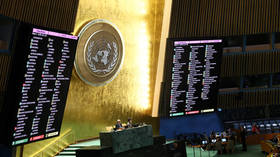US Space Force activates first overseas command

The newest US military branch, Space Force, has established its first command on foreign soil, setting up in South Korea amid increasing tensions with China, Russia and North Korea.
The new unit was formally launched in an activation ceremony on Wednesday at Osan Air Base, about 65km (40 miles) south of Seoul. It will help coordinate space operations on the divided peninsula, such as detecting missile launches by North Korea and overseeing satellite communications.
The deployment “enhances our ability to defend the homeland and ensure peace and security on the Korean Peninsula and in Northeast Asia,” US Army General Paul LaCamera, commander of the 28,500 US troops stationed in South Korea, said at the ceremony.
Asked how US adversaries should interpret the move, the new unit’s commander, Lt. Colonel Joshua McCullion said he hoped it would deter conflicts. “The hope is that they see we are ready. Myself and my guardians are ready to go, day or night. That’s (the message) we want the adversary, whoever the adversary is, to take.”
Our presence around the globe continues to grow! #PartnersinSpacehttps://t.co/Xgt690fANE
— United States Space Force (@SpaceForceDoD) December 14, 2022
The US Space Force was formed in 2019 and opened its Indo-Pacific regional command center in Hawaii last month. The Korea command is a subcomponent of US Space Force Indo-Pacific. America’s military has about 750 bases in 80 countries around the world and has drawn criticism for also weaponizing space. The Pentagon has countered that the US must treat space as a “war-fighting domain” because of threats from Russia and China.
The Outer Space Treaty of 1967, which was signed by the US, the Soviet Union, and UK, pledged to set aside space for “peaceful purposes.”
The two Koreas remain technically at war because their 1950-1953 conflict ended in an armistice, not a peace treaty. Saber-rattling by the two countries, including missile tests by Pyongyang, has escalated this year, with North Korean leader Kim Jong-un vowing an “all-out” nuclear response to US aggression.
However, Space Force chose Asia-Pacific for its first regional command center largely because of concern over China, which the Pentagon under Secretary of Defense Lloyd Austin has labeled the top threat to US national security. “Every day, Secretary Austin reminds us of the pacing challenge, and that’s China,” General David Thompson, vice chief of space operations, told reporters last month.














